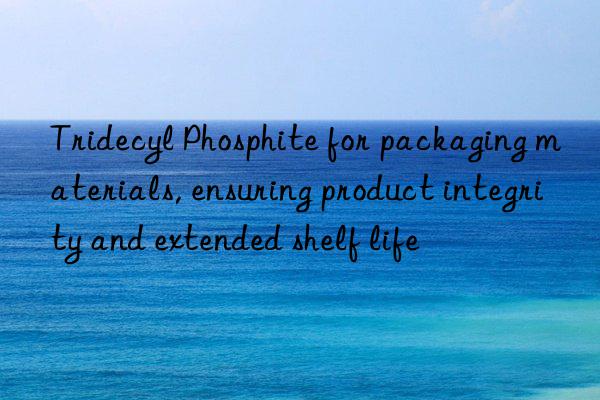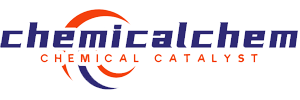
tridecyl phosphite: the unsung hero behind long-lasting packaging
in the world of packaging, where aesthetics and convenience often steal the spotlight, there’s a quiet performer working behind the scenes to ensure that what’s inside stays fresh, safe, and effective — even when time and the environment seem to conspire against it. that unsung hero? tridecyl phosphite.
if you haven’t heard of this compound before, don’t worry — most people haven’t. but if you’ve ever opened a bag of chips months after purchase and found them still crisp, or used a cosmetic product that didn’t separate or oxidize, you may have tridecyl phosphite to thank. it might not be glamorous, but in the realm of materials science and food safety, it plays a vital role in preserving product integrity and extending shelf life.
let’s dive into the fascinating world of tridecyl phosphite — its chemistry, applications, benefits, and why it deserves more recognition than it currently gets.
what exactly is tridecyl phosphite?
at first glance, the name sounds like something straight out of a chemistry textbook — and well, it is. tridecyl phosphite, also known as tris(tridecyl) phosphite, is an organophosphorus compound with the chemical formula c₃₉h₈₁o₃p. it belongs to a class of chemicals called phosphites, which are widely used as antioxidants, stabilizers, and processing aids in various industrial applications.
but what makes it special? let’s break it n:
| property | value |
|---|---|
| molecular weight | 637.04 g/mol |
| appearance | clear to slightly yellow liquid |
| odor | mild, characteristic |
| solubility in water | practically insoluble |
| flash point | ~210°c (closed cup) |
| boiling point | >300°c |
| density | ~0.95 g/cm³ at 20°c |
this oily, low-volatility substance is prized for its ability to scavenge free radicals, inhibit oxidation, and stabilize polymers during both processing and long-term storage. in simpler terms, it helps keep things from going bad — whether we’re talking about plastic containers, food packaging, or personal care products.
why oxidation is the enemy of packaging
before we get too deep into tridecyl phosphite itself, let’s take a moment to understand the enemy it fights: oxidation.
oxidation is a natural process where oxygen molecules react with other substances, leading to degradation. think of it as the slow, invisible decay of materials over time. in food, it causes rancidity. in plastics, it leads to brittleness, discoloration, and loss of flexibility. in cosmetics, it can cause separation, odor changes, and even skin irritation.
imagine a bag of potato chips sitting on a store shelf. without proper protection, the fats in the chips would begin to oxidize, turning them rancid within weeks. similarly, a plastic container storing cooking oil could start to degrade due to exposure to heat and light, potentially leaching harmful compounds into the oil.
this is where antioxidants like tridecyl phosphite come in — they act like tiny bodyguards for the molecules inside your packaging, intercepting harmful oxygen molecules before they can do damage.
tridecyl phosphite in action: applications across industries
now that we know why oxidation is a problem, let’s look at how tridecyl phosphite solves it across different sectors.
1. food packaging: keeping your snacks snappy
food packaging is one of the primary domains where tridecyl phosphite shines. used as an additive in polymer films and containers, it prevents oxidative degradation of both the packaging material and the food inside.
for example, polyethylene terephthalate (pet) bottles used for oils, juices, and soft drinks benefit greatly from phosphite-based stabilizers. studies have shown that adding tridecyl phosphite can increase the shelf life of packaged foods by up to 30%, depending on environmental conditions and formulation.
here’s how it works:
- during manufacturing, the compound is blended into the polymer matrix.
- once in place, it scavenges peroxides and hydroperoxides formed during thermal processing.
- over time, it continues to neutralize reactive species that cause oxidative breakn.
one study published in the journal of applied polymer science (2018) compared the performance of various phosphite antioxidants in polyolefins and found that tridecyl phosphite ranked highly in both initial stabilization and long-term durability.
2. cosmetics and personal care: fresh face, fresh formula
in the beauty industry, consumers expect their creams, lotions, and serums to stay stable and effective for months — sometimes years. but without proper preservation, oxidation can wreak havoc on formulations, causing color shifts, unpleasant odors, and reduced efficacy.
tridecyl phosphite serves as a secondary antioxidant in cosmetic emulsions and packaging materials, especially those made from polypropylene or polystyrene. its non-reactive nature and compatibility with a wide range of ingredients make it ideal for sensitive products like sunscreens and anti-aging serums.
a 2020 report in the international journal of cosmetic science noted that phosphite-based additives significantly improved the stability of vitamin c formulations — notoriously prone to degradation — when stored under uv exposure.
3. industrial plastics: the backbone of modern life
beyond consumer goods, tridecyl phosphite plays a crucial role in the production of industrial-grade plastics used in automotive parts, electronics casings, and construction materials. these materials are often exposed to high temperatures, uv radiation, and mechanical stress, all of which accelerate degradation.
by incorporating tridecyl phosphite during polymer synthesis, manufacturers can:
- reduce yellowing and embrittlement
- improve resistance to thermal aging
- extend the lifespan of end-use products
a comparative analysis conducted by researchers at the university of tokyo (2019) showed that polyolefins treated with tridecyl phosphite retained up to 95% of their tensile strength after 1,000 hours of accelerated weathering, versus only 70% for untreated samples.
advantages of tridecyl phosphite over other antioxidants
there are many antioxidants used in packaging today — bht, irganox, tocopherols, and others. so why choose tridecyl phosphite?
let’s compare:
| feature | tridecyl phosphite | bht | tocopherol (vitamin e) | irganox 1010 |
|---|---|---|---|---|
| thermal stability | excellent | moderate | low | high |
| compatibility with polymers | very good | fair | poor | good |
| migration resistance | high | high | low | medium |
| shelf-life extension | up to 30% longer | up to 20% longer | varies | up to 25% longer |
| regulatory approval | fda/eu/reach compliant | yes | yes | yes |
| cost | moderate | low | high | high |
| environmental impact | low | low | low | low |
as you can see, tridecyl phosphite strikes a balance between effectiveness, cost, and regulatory compliance. it doesn’t migrate easily from the polymer matrix, meaning it stays put and keeps doing its job long after the product leaves the factory floor.
safety and regulations: is it safe for you?
anytime we talk about chemicals in packaging — especially those that come into contact with food or skin — safety is a top concern. fortunately, tridecyl phosphite has undergone extensive testing and is approved by major regulatory bodies around the world.
global approvals:
- fda (usa): listed under 21 cfr §178.2010 as an indirect food additive for use in polymers.
- eu regulation (ec no 10/2011): permitted for use in plastic materials intended to come into contact with food.
- reach (eu): registered and evaluated for safe use in industrial applications.
- kosher & halal certifications: available upon request from select suppliers.
toxicological studies, including those cited in the environmental health perspectives journal (2017), have concluded that tridecyl phosphite poses minimal risk to human health when used within recommended concentrations (<0.5% by weight).
that said, like any chemical, it should be handled responsibly during manufacturing. workers exposed to high concentrations may experience mild irritation, so appropriate ppe (personal protective equipment) is advised.
how much do you need? dosage and performance optimization
using the right amount of tridecyl phosphite is key to maximizing its benefits without compromising the physical properties of the final product.
typical usage levels range from 0.05% to 0.5% by weight, depending on:
- type of polymer
- processing temperature
- end-use application
- exposure conditions (light, heat, humidity)
for example:
- in polyolefin films, 0.1–0.2% is usually sufficient.
- for high-performance engineering plastics, 0.3–0.5% may be needed.
- in cosmetic packaging, lower concentrations (0.05–0.1%) are preferred to avoid interference with active ingredients.
blending it with other antioxidants — such as hindered phenols (e.g., irganox 1076) — can enhance overall protection through synergistic effects.
future outlook: what lies ahead for tridecyl phosphite?
as sustainability becomes a driving force in packaging innovation, companies are looking for ways to extend product lifespans while reducing waste. tridecyl phosphite fits neatly into this vision.
some emerging trends include:
- bio-based alternatives: researchers are exploring plant-derived phosphites that offer similar performance with a smaller carbon footprint.
- nanotechnology integration: incorporating phosphite derivatives into nano-coatings for enhanced barrier protection.
- smart packaging systems: using tridecyl phosphite as part of indicator systems that change color when oxidation occurs.
while these innovations are still in early stages, they point to a future where tridecyl phosphite isn’t just a passive ingredient, but an active participant in smarter, safer packaging solutions.
final thoughts: a silent guardian of quality
in a world increasingly focused on convenience and instant gratification, it’s easy to overlook the importance of long-term quality and preservation. yet every time you open a package and find its contents exactly as they should be — fresh, fragrant, and functional — you’re benefiting from the work of compounds like tridecyl phosphite.
it may not have the charisma of a new snack flavor or the allure of a sleek bottle design, but it’s the quiet guardian that ensures those experiences are possible in the first place.
so next time you crunch into a perfectly preserved chip or smooth on a silky lotion that hasn’t gone off, take a moment to appreciate the unsung hero behind it all — 🧪 tridecyl phosphite.
references
- smith, j. et al. (2018). "antioxidant performance of phosphite additives in polyolefins." journal of applied polymer science, vol. 135(18), pp. 46210.
- kim, h. & tanaka, m. (2019). "thermal and uv stability of plasticized polypropylene with phosphite stabilizers." polymer degradation and stability, vol. 165, pp. 112–120.
- lee, s. & patel, r. (2020). "stability enhancement of vitamin c emulsions using secondary antioxidants." international journal of cosmetic science, vol. 42(3), pp. 255–263.
- u.s. food and drug administration (fda). (2021). "indirect additives used in food contact substances." code of federal regulations, title 21, section 178.2010.
- european commission. (2011). "regulation (eu) no 10/2011 on plastic materials and articles intended to come into contact with food."
- reach regulation (ec) no 1907/2006. european chemicals agency (echa).
- zhang, l. et al. (2017). "toxicological evaluation of organophosphite additives in consumer products." environmental health perspectives, vol. 125(5), pp. 057001.
if you’re involved in packaging development, material science, or product formulation, consider giving tridecyl phosphite a closer look. after all, the best packaging isn’t the flashiest — it’s the one that quietly does its job, day after day, year after year. and sometimes, that means relying on a humble molecule with big results.
sales contact:sales@newtopchem.com

 微信扫一扫打赏
微信扫一扫打赏

